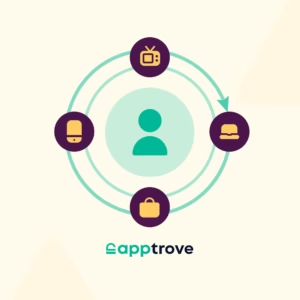Introduction: Why View Through Attribution Matters Now
Have you ever scrolled past an ad, don’t click, but it still sticks with you? Maybe a few days later, you’re in the App Store or browsing online and—boom—you recognize the brand and go for it. No click. Just a memory.
That’s exactly the kind of moment most analytics miss.
Traditional attribution gives all the credit to the last click. But what about the impression that actually planted the idea in someone’s head? That quiet influence is often what really drives conversions, and that’s where View-Through Attribution (VTA) comes in. If you’re still relying on last-click models, this article breaks down why traditional attribution tracking often fails modern marketers.
View-Through Attribution (VTA) helps you capture the impact of your ads even when there’s no direct click. It tells you, “Hey, someone saw this, didn’t act right away, but came back later and converted.” In other words, it fills in the blanks that click-only tracking leaves behind.
And with all the changes to privacy, especially since iOS 14.5 and the whole IDFA shakeup, those blanks are getting bigger. VTA offers a privacy-friendly way to get smarter about what’s working.
This guide breaks it all down: what VTA is, how it works, when to use it, and how to make it part of a smarter, more complete growth strategy. By the end, you won’t just be tracking better—you’ll be marketing smarter.
What is View-Through Attribution?
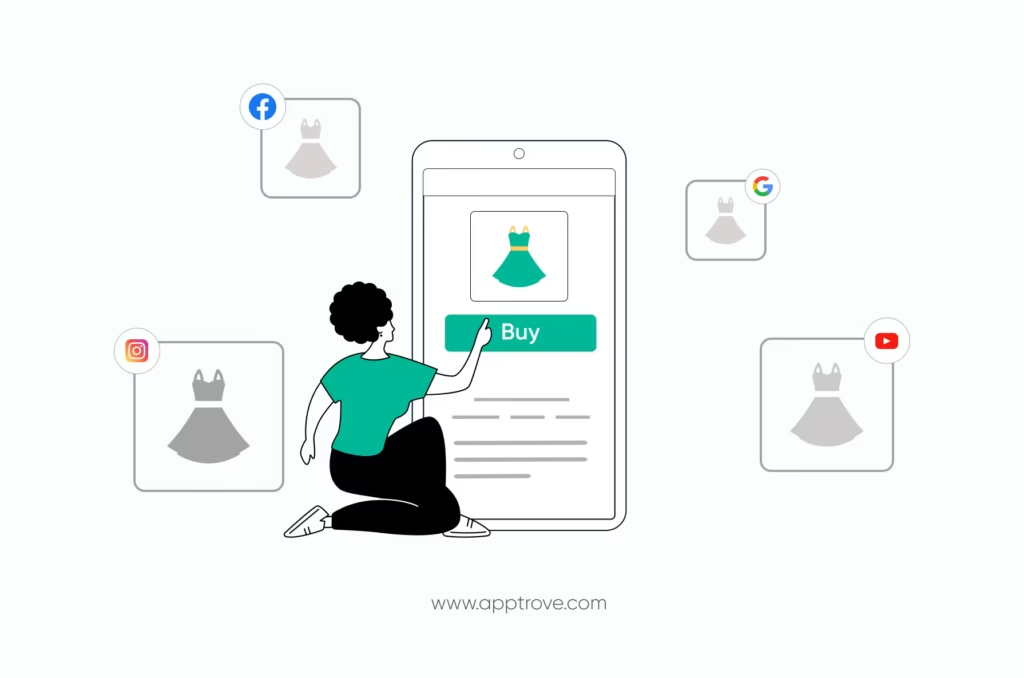
Picture this: someone scrolls past your Instagram ad, doesn’t tap it, but remembers your brand. Three days later, they search for your app directly and download it. Traditional tracking would miss that connection entirely, but view-through attribution connects the dots.
This is completely different from click-through attribution, which only counts conversions right after someone clicks your ad. That’s like only crediting the last person who talked to a customer before they bought something, while completely ignoring everyone else who influenced the decision.
The real magic happens in understanding how people actually behave. We don’t see an ad and immediately drop everything to download an app. We’re more subtle than that. Maybe we see your fitness app ad while scrolling at lunch, but don’t act until we’re lying in bed that night, feeling guilty about skipping the gym again.
That’s the psychology of impressions at work—those quiet moments where your brand plants a seed in someone’s mind. If you’re only measuring clicks, you’re completely missing these influential touchpoints that often drive the decisions that matter most.
Want to go deeper? Read this guide on uncovering the hidden power of View-Through Attribution.
How View-Through Attribution (VTA) Actually Works Behind the Scenes
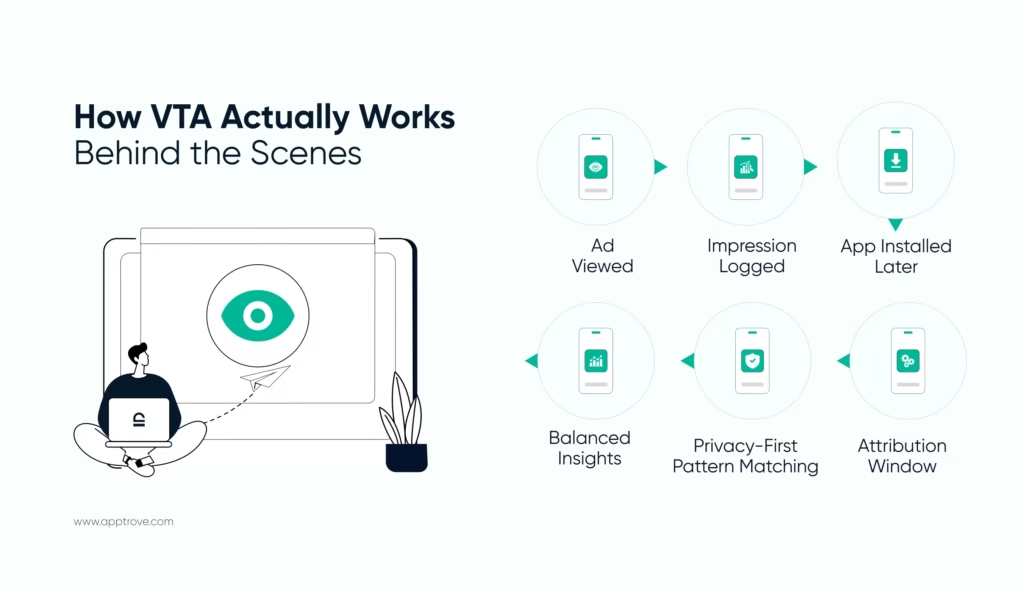
Impression Tracking Made Simple
When someone sees your ad, whether it’s a banner they barely notice, a video they watch halfway through, or one of those full-screen ads, the ad network quietly logs that moment. It records the timestamp, basic device info like what phone they’re using, and sometimes general location data. No personal details, just digital breadcrumbs.
If that person downloads your app later, the system connects those dots. It’s like having a really good memory for faces—”Hey, didn’t I see you at that coffee shop last week?”
Attribution Windows: The Time Limits That Matter
Not every impression gets to claim credit forever. That would be chaos. We use attribution windows—basically, time limits for when an impression can take credit for a conversion.
Think of it like this: if someone sees your ad on Monday and downloads your app on Tuesday, that’s probably connected. But if they download it three weeks later? That’s probably not your ad’s influence anymore.
Most attribution windows run anywhere from 24 hours to 7 days. It’s like having a statute of limitations for ad influence. Choose too short and you’ll miss real connections. Go too long and you’ll start crediting ads for things they probably didn’t cause.
Modern Privacy-Focused Tracking
The days of invasive user tracking are ending, and that’s actually a good thing. Modern view through attribution works with aggregated data patterns rather than following individual users around the internet.
Instead of tracking every move someone makes, we look for broader patterns: “Someone with this type of device in this general area saw our ad, and someone matching that profile downloaded our app later.” It’s not 100% perfect, but when you combine multiple signals, it gets pretty accurate.
This approach respects privacy while still giving you the insights you need to make smart campaign decisions.
When View-Through Attribution (VTA) Makes Perfect Sense (And When It Doesn’t)
Where VTA Absolutely Crushes It
Connected TV campaigns are probably the best example. People are lounging on their couch, watching their favorite show, and your ad plays during a commercial break. They’re not going to grab their phone mid-episode, but that doesn’t mean your ad didn’t work.
Social media feeds are another goldmine. Everyone’s scrolling at lightning speed through Instagram or TikTok. Your ad gets maybe two seconds of eyeball time before they swipe past. But those two seconds can be surprisingly powerful.
Display advertising works similarly. Someone’s reading an article about productivity tips, and your project management software banner sits quietly at the top of the page. They finish reading, close the tab, but remember your brand later when they’re frustrated with their current tool.
Perfect for Early-Stage Campaigns
When you’re launching a new app or testing fresh creative, view-through attribution becomes your best friend. You’re not trying to get immediate downloads from people who’ve never heard of you. You’re planting seeds.
Maybe you’re launching a meditation app and want to see if your “Find Your Calm” campaign is actually reaching stressed-out professionals. Traditional click tracking might show disappointing results, but view-through attribution could reveal that people are seeing your ads during their lunch break and downloading your app later that evening when they actually need it.
When to Skip View-Through Attribution (VTA)
If you’re running high-intent campaigns where people are actively searching for solutions and ready to download immediately, traditional click tracking probably tells the whole story. Why complicate things?
The same goes for ad placements where impression tracking is unreliable. If you can’t trust that the data accurately reflects who actually saw your ad, the whole exercise falls apart.
And if you’re dealing with products that require weeks of research and comparison shopping, trying to connect one random impression to a purchase months later feels like a stretch.
Making View-Through Attribution (VTA) Work in Your Attribution Strategy

Multi-Touch Attribution Gets Better
View-through attribution fills in those mysterious gaps where someone goes from never hearing about you to installing your app with zero tracked touchpoints in between. It gives proper credit to early exposures that plant seeds but don’t get immediate clicks.
If you’re already running multi-touch attribution, you know it’s about giving credit to every step in someone’s journey. The problem is, most attribution models only count steps where someone actually clicked something.
Think about your own behavior for a second. How often do you see an ad, make a mental note, but not click it right away? Maybe you’re on the subway with spotty wifi, or you’re in the middle of something else. Those moments still influence your decision, even if there’s no click to track.
Understanding Real Campaign Impact
Here’s a question that keeps most marketers up at night: “Did my campaign actually work, or would these people have converted anyway?”
When you factor in view-through attribution, you can actually compare how people who saw your ads behaved versus those who never saw them at all. You’re measuring real influence, not just who happened to click at the right moment.
Rethinking First-Touch and Last-Touch Models
Traditional attribution loves to play favorites—either the first click gets all the credit, or the last one does. But anyone who’s ever bought anything knows that’s not how decisions actually work.
Here’s a real example: someone sees your fitness app ad on Instagram while eating lunch. They don’t click because they’re busy. Later that week, they catch your YouTube ad while watching workout videos. Still no click. Then finally, they’re feeling motivated on Sunday morning, search for “best fitness apps,” and click on your search ad.
If you only credit that final search click, you’re completely ignoring the two previous touchpoints that primed them to search for fitness apps in the first place. View-through attribution helps you see the whole story.
The Metrics That Actually Matter
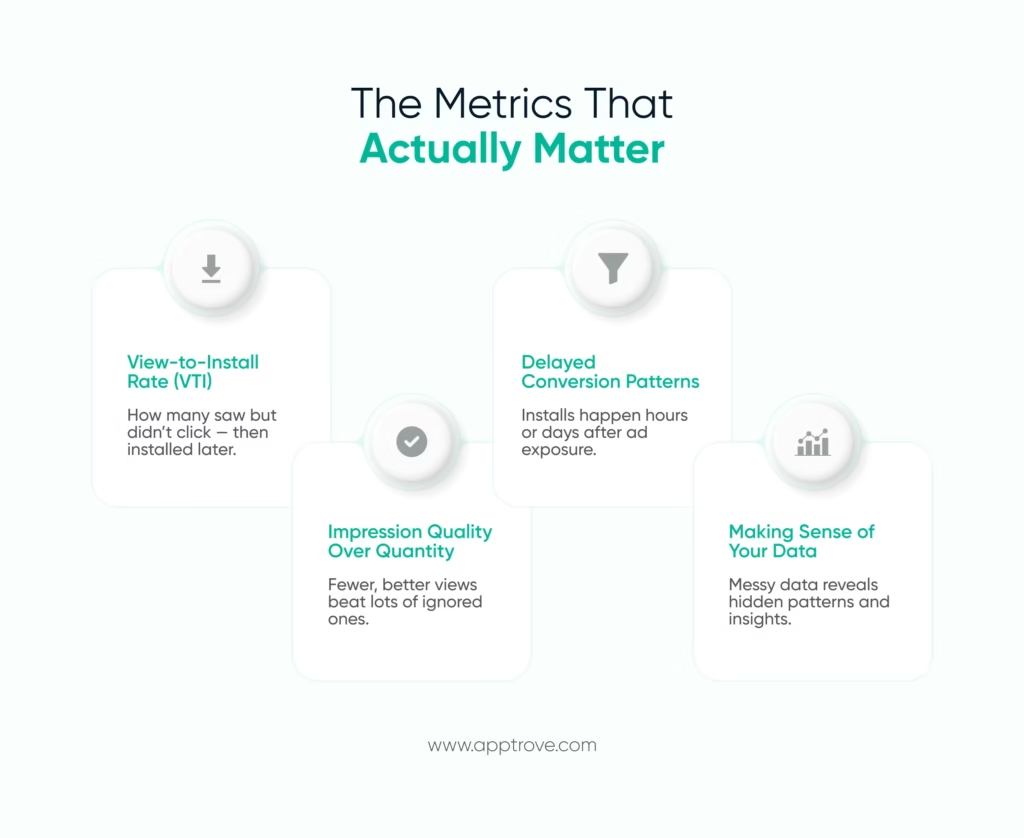
View-to-Install Rate (VTI)
This is probably your most important VTA metric. It shows how many people saw your ad, didn’t click, but still downloaded your app later. When this number starts climbing, you know you’re cutting through the noise and actually sticking in people’s minds.
Impression Quality Over Quantity
Not every eyeball is worth the same. Maybe your TikTok ads get tons of views but low conversions, while your Reddit placements get fewer views but much higher VTI rates. Those patterns tell you where your message actually resonates versus where it just gets seen.
Delayed Conversion Patterns
These are installs that happen hours or days after someone sees your ad. When you spot patterns here, like consistently getting more installs on Tuesdays after weekend ad exposure, you’re seeing how your creative actually works in the real world.
Maybe you notice that your video ad about productivity keeps leading to installs two days later, right around Sunday evening, when people are planning their week. Or maybe that banner ad on a finance blog seems slow to convert, but when people do install, they become your most engaged users.
Making Sense of Your Data
Here’s what nobody tells you about VTA data: it’s messy. You won’t get those clean, straight lines from impression to install that make for pretty reports. But that messiness is actually where the good stuff lives.
The real value is spotting patterns that help you understand not just what works, but when and why it works. It turns your attribution from a reporting exercise into actual discovery about your audience.
Privacy and View-Through Attribution (VTA): The New Reality
Privacy isn’t some marketing trend that’s going to blow over. It’s completely changed how we do business, and smart marketers are treating it as an opportunity instead of an obstacle.
What You Can Track vs. What You Should
Just because you can collect data doesn’t mean you should. The smart approach with view-through attribution is focusing on patterns that genuinely help you make better decisions.
Instead of trying to track every single impression, ask yourself: “Will knowing this actually change how I run my campaigns?” and “Am I respecting the fact that real people are behind this data?”
It’s about quality over quantity. Better to have solid insights about campaign trends than sketchy data about individual users that might not even be accurate—or legal—six months from now.
Future-Proofing Your Strategy
The privacy landscape is still changing fast, and anyone who tells you they know exactly what it’ll look like in two years is probably selling something. But if you build your view-through attribution strategy around trust and flexibility, you’ll be ready for whatever comes next.
Focus on aggregated VTA data that tells you about campaign performance without getting into individual user details. Use tight attribution windows that make sense—if someone installs your app two weeks after seeing an ad, that’s probably not your ad’s influence anyway.
Common View-Through Attribution (VTA) Mistakes (And How to Avoid Them)
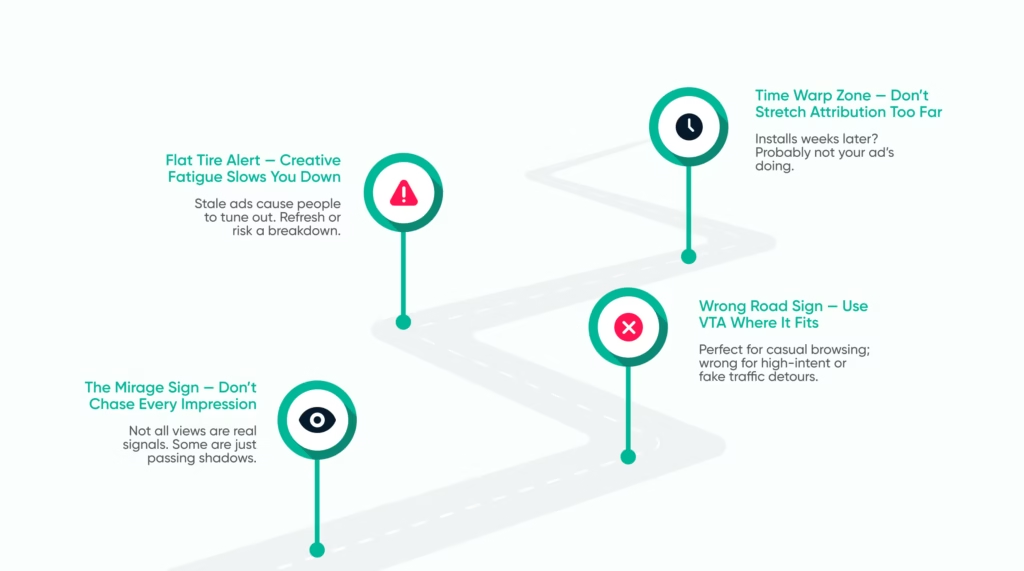
Don’t Over-Credit Every Impression
This is probably the biggest trap marketers fall into. They start tracking impressions, and suddenly every single ad view becomes this precious signal that deserves credit for everything that happens afterward.
But here’s the reality: most impressions are garbage. Someone scrolls past your ad in 0.3 seconds while they’re distracted, or your banner loads at the bottom of a page they never scroll down to see. Just because your tracking system recorded an “impression” doesn’t mean anything meaningful happened.
The fix is focusing on impression quality instead of just counting every view. Look for patterns—are people who saw your ad actually behaving differently than those who didn’t? Are they coming back to install your app at higher rates? That’s your real signal.
Using VTA in the Wrong Context
View-through attribution works great when people are casually browsing—watching TV, scrolling through social feeds, or reading articles. Those are moments where your ad can plant a seed without expecting immediate action.
But if you’re running search ads where people are actively looking for solutions, or if you’re buying traffic from sketchy sources that generate fake impressions, VTA becomes meaningless. You’re trying to measure influence in situations where people either already have high intent or where the “views” aren’t even real.
Ignoring Creative Fatigue
This one’s sneaky because it doesn’t show up in your data immediately. You launch a campaign, your view-through attribution numbers look good, so you keep running the same creative for months.
But here’s what happens: people start tuning out your ad. They’ve seen it a dozen times, so even though it technically counts as an “impression” each time, it’s not actually registering in their brain anymore.
Watch for performance trends religiously. If your view-to-install rate starts declining even though impression volume stays steady, that’s usually a sign your creative needs a refresh.
Misinterpreting Time-to-Install Metrics
View-through attribution often involves delayed conversions—people who install your app hours or days after seeing your ad. That’s totally normal and expected.
But not every delay tells the same story. Someone who installs your fitness app the morning after seeing your “New Year, New You” ad on Sunday night? That’s probably connected. Someone who installs it three weeks later? That’s probably not your ad’s doing.
Keep your attribution windows realistic. For most apps, 1-7 days makes sense, depending on your industry. If you’re seeing “influenced” installs happening weeks after ad exposure, you’re probably giving yourself credit for coincidences rather than actual influence.
Your VTA Action Plan: Getting Started Today
Make Your Ad Views Count
If someone’s going to see your ad for three seconds and then move on with their life, you better make those three seconds count. Most impressions are completely forgettable, but the ones that stick are what drive those delayed conversions.
Think about where people’s heads are when they see your ad. If they’re mindlessly scrolling through TikTok, your creative needs to stop them mid-scroll. If they’re watching TV and your ad comes on during a commercial break, you need to be entertaining enough that they don’t tune out.
Make your branding big and clear—if someone can’t remember who the ad was for, the whole exercise is pointless. Tell a quick story that makes sense even without sound. And make sure your message matches the platform.
Keep Your Tracking Clean
View-through attribution is only as good as the data feeding into it. If your impression tracking is messy, your VTA insights will be garbage.
Start with the basics: make sure your impression tags are actually working across all your placements. Check that you’re not double-counting impressions when someone sees your ad on both their phone and tablet. Set up regular audits to catch data quality issues before they mess up your optimization decisions.
Build VTA into Your Regular Reporting
Don’t make view-through attribution some special report that you only look at when you’re trying to justify campaign performance. If it’s important enough to track, it’s important enough to include in your regular performance conversations.
Build VTA metrics into your regular dashboards. Track view-to-install rates right next to your click-through rates. Compare the quality and lifetime value of users who came through clicks versus impressions. Look for patterns in when delayed conversions happen.
Work With Your Media Partners
Your ad networks, DSPs, and platform reps want your campaigns to succeed because your success is their success. But most marketers treat these relationships like purely transactional exchanges instead of collaborative partnerships.
Ask your partners about the impression of delivery quality. Find out which placements actually drive viewable impressions versus those that just rack up numbers. Test new creative formats together. Discuss attribution window optimization based on what they’re seeing across similar campaigns.
Your partners see data across hundreds of campaigns. They know patterns you don’t. But they’ll only share those insights if you ask the right questions and treat them like actual partners.
The Future of View-Through Attribution

Cross-Device Attribution Becomes Essential
People are digital nomads now. They’ll catch your ad during their morning coffee while watching connected TV, Google your app during lunch on their work laptop, research reviews on their tablet during their commute, and finally hit install on their phone right before bed.
Without a cross-device approach, you’re essentially playing detective with half the clues missing. You might think your TV campaign flopped when it actually planted the seed that grew into a conversion three devices later.
The next generation of attribution methods can connect these scattered touchpoints and show you the real customer journey. Think of it as having a GPS for user behavior that tracks every turn, even when they switch vehicles.
According to recent research, Nike’s cross-device campaign shows the power of unified omnichannel attribution: by tailoring messages across devices, they saw a 32% increase in mobile conversions, 60% more mobile revenue, and 2x cross-device sales—proof that the real magic happens when you optimize based on cross-device insights.
Real-Time Optimization
The future isn’t just about measuring what happened—it’s about using those insights to optimize what happens next. Real-time view-through attribution is enabling dynamic campaign adjustments that would have been impossible just a few years ago.
Imagine your campaigns automatically shifting budget toward creatives that are generating strong view-through influence, or adjusting frequency caps based on VTA data to maximize impact without annoying users. This isn’t science fiction—it’s happening right now for marketers who are ahead of the curve.
View-Through Attribution (VTA) Glossary: Terms You Need to Know
View-Through Attribution (VTA): The practice of giving credit to ads that were seen but not clicked, yet still contributed to conversions within your attribution window. It recognizes that influence doesn’t always require immediate action.
Attribution Window: Your measurement timeframe—the period during which you’ll give credit to an ad impression for influencing a conversion. Typically, 1-7 days for mobile apps.
View-to-Install Rate (VTI): How many people saw your ad, didn’t click, but still downloaded your app later. Your most important VTA metric.
Impression: When your ad loads and appears on a user’s screen, whether they pay attention or not. The foundation of view-through attribution.
Viewability: Whether your ad was actually visible to users, not just served to their device. Industry standards typically require at least 50% of the ad to be visible for 1-2 seconds.
Cross-Device Attribution: Tracking user behavior across multiple devices—phone, tablet, laptop, connected TV. Essential because users often see ads on one device but convert on another.
Post-View Conversion: Any conversion that happens after a user sees your ad, regardless of whether they clicked. The broader category that VTA focuses on.
Incrementality: Measuring whether your ads actually created new conversions or just took credit for conversions that would have happened anyway. The holy grail of attribution.
Ready to Transform Your Attribution?
Stop obsessing over clicks. Start paying attention to those delayed conversions and the quiet ways your ads influence people. Your audience isn’t static, your creatives get stale, and your channels evolve—your attribution tracking needs to keep up with all of that.
You’re not just counting app installs anymore. You’re figuring out how people go from “never heard of you” to “just downloaded your app.” And that understanding? That’s what separates good marketers from great ones.
The brands winning with view-through attribution aren’t just measuring better—they’re thinking differently about influence, impact, and the real customer journey. They understand that the most powerful marketing moments often happen in silence, without clicks, without immediate action.
But they leave lasting impressions that drive decisions when it matters most.
Start tracking smarter today—and never miss the impact of an impression again.
Ready to see what your campaigns are really doing?
Start your free trial today and begin tracking smarter with real view-through attribution insights. No guesswork. No fluff. Just clarity.
Never miss the impact of an impression again.






